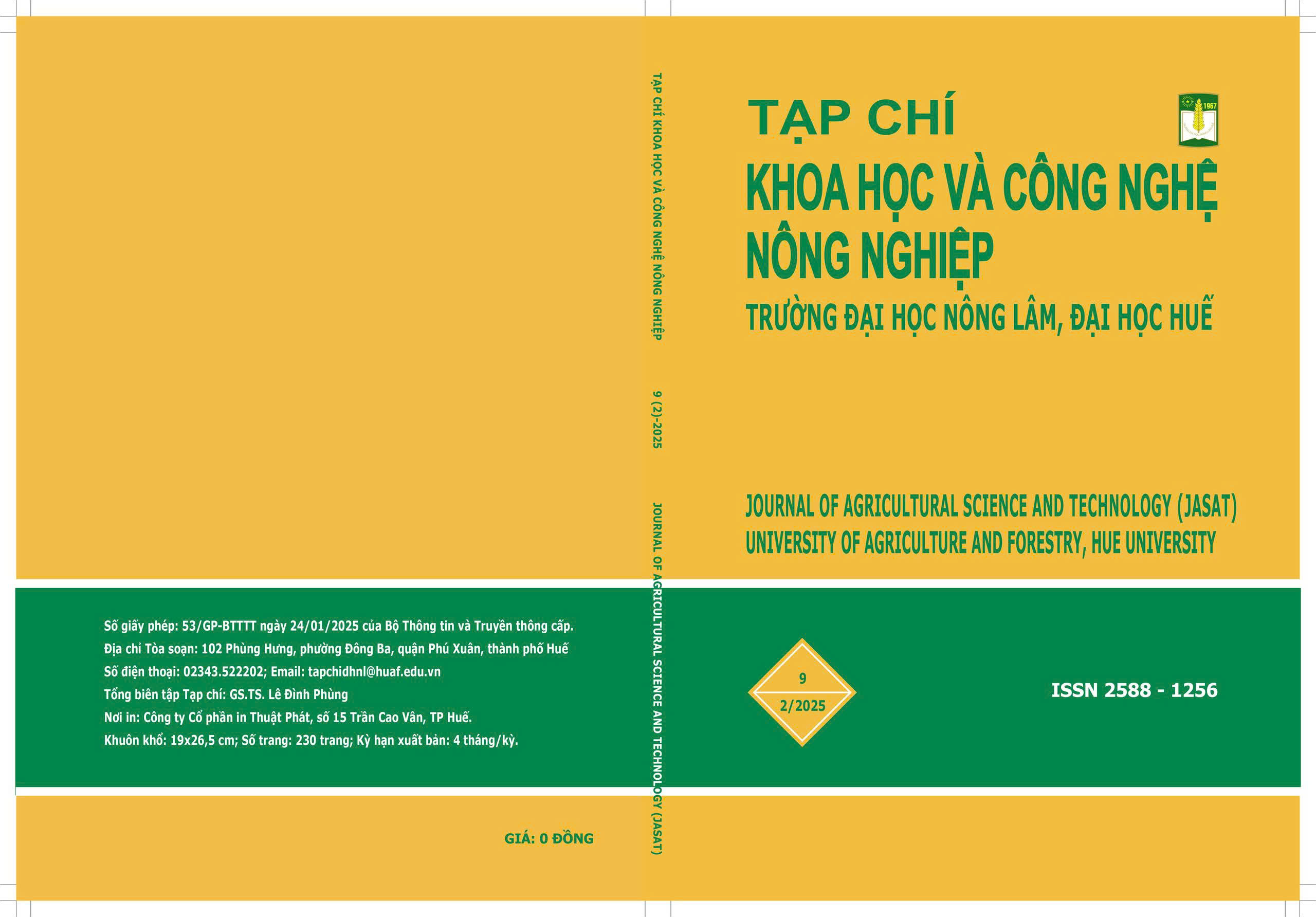##plugins.themes.huaf_theme.article.main##
Abstract
The study was conducted to evaluate the physical and chemical properties, selenium and certain heavy metals content in agricultural soil. Soil parameters were analyzed using widely accepted methods and compared with Vietnamese standards and those established by the World Health Organization WHO, 2009. The research results indicated that the soil at the study site was highly acidic, with pHH2O at 4.60±0.58 and pHKCl at 4.35±0.86. Other parameters included: P2O5(dt) at 12.07±5.49 mg/kg, available potassium K2O(dt) at 14.84±4.95 mg/kg, organic carbon (OC) at 2.45±0.69%, total nitrogen N(ts) at 0.13±0.02%, total phosphorus P2O5(ts) at 12.07±5.49 mg/kg, and total potassium K2O(ts) at 0.17±0.05 mg/kg. The average selenium content was 1.04±0.23 mg/kg dry soil, which is lower than the WHO guidelines, 2009. Therefore, it is necessary to implement measures to supplement selenium to ensure that crops receive adequate nutrients. At the time of the study, the soil showed no contamination with heavy metals such as copper (Cu, As, Pb, Cd, Hg) and zinc (Zn). However, the Cr and Ni content was measured at 273,17and 196,90mg/kg dry soil. This level exceeds the thresholds established in QCVN 03: 2015/BTNMT, indicating significant contamination with Cr and Ni, necessitating appropriate remediation strategies.
##plugins.themes.huaf_theme.article.details##
References
Lê Văn Khoa, Nguyễn Xuân Cự, Bùi Thị Ngọc Dung, Lê Đức, Trần Khắc Hiệp và Cái Văn Tranh. (2001). Phương pháp phân tích đất, nước, phân bón, cây trồng. Hà Nội, Việt Nam: Nhà xuất bản Giáo dục.
Lê Văn Khoa, Trần Thiện Cường và Lê Văn Thiện. (2009). Dinh dưỡng khoáng thực vật. Hà Nội, Việt Nam: Nhà xuất bản Khoa học và Kỹ thuật.
Nguyễn Văn Bộ. (2003). Dinh dưỡng cây trồng. NXB Nông nghiệp.
Nguyễn Văn Khải .(2018). Khảo sát hàm lượng kim loại nặng trong một số loại phân bón và đất canh tác tại miền Đông Nam bộ. Tạp chí Khoa học và Công nghệ Nông nghiệp Việt Nam, 68, 21–27.
Trần Văn Chính. (2000). Giáo trình Thổ nhưỡng học. Hà Nội, Việt Nam: Nhà xuất bản Đại học Nông Nghiệp 1.
Alloway, B. J. (2013). Heavy Metals in Soils: Trace Metals and Metalloids in Soils and their Bioavailability. Springer
Arthur, J. R., McKenzie, R. C., & Beckett, G. J. (2003). Selenium in the immune system. The Journal of Nutrition, 133(5), 1457S-1459S. DOI:10.1093/jn/133.5.1457S
FAO. (2005). Fertilizer use by crop in Vietnam. FAO Soils Bulletin
Gailer, J. (2009). Chronic toxicity of AsIII in mammals: The role of (GS)2AsSe−. Biochimie, 91(10), 1268-1272. Retrieved from https://pubmed.ncbi.nlm.nih.gov/19539009/
Hartikainen, H. (2005). Biogeochemistry of selenium and its impact on food chain quality and human health. Journal of Trace Elements in Medicine and Biology, 18(4), 309-318. DOI:10.1016/j.jtemb.2005.02.009
Kabata-Pendias, A., & Pendias, H. (2001). Trace Elements in Soils and Plants (3rd ed.). CRC Press.
Li, J., Yang, W., Guo, A., Qi, Z., Chen, J., Huang, T., Yang, Z., Gao, Z., Sun, M., & Wang, J. (2021). Combined foliar and soil selenium fertilizer increased the grain yield, quality, total Se, and organic Se content in naked oats. Journal of Cereal Science, 100, 103265. DOI:10.1016/j.jcs.2021.103265
Proietti, P., Nasini, L., Del Buono, D., D’Amato, R., Tedeschini, E., & Businelli, D. (2013). Selenium protects olive (Olea europaea L.) from drought stress. Scientia Horticulturae, 164, 165-171. DOI:10.1016/j.scienta.2013.09.034
WHO. (2009). Chemicals of Public Health Concern: Selenium in Drinking Water and Soil.
Zeng, H., Uthus, E. O., & Combs, G. F., Jr. (2005). Mechanistic aspects of the interaction between selenium and arsenic. Journal of Inorganic Biochemistry, 99(6), 1269-1274. Retrieved from https://pubmed.ncbi.nlm.nih.gov/15917080/
Zhu, Y. G., Pilon-Smits, E. A., Zhao, F. J., & Williams, P. N. (2009). Selenium in higher plants: understanding mechanisms for biofortification and phytoremediation. Trends in Plant Science, 14(8), 436-442


